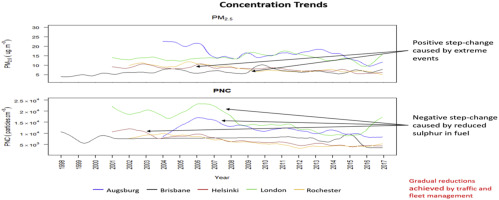当前位置:
X-MOL 学术
›
Environ. Pollut.
›
论文详情
Our official English website, www.x-mol.net, welcomes your
feedback! (Note: you will need to create a separate account there.)
Long-term trends in PM2.5 mass and particle number concentrations in urban air: The impacts of mitigation measures and extreme events due to changing climates.
Environmental Pollution ( IF 7.6 ) Pub Date : 2020-04-02 , DOI: 10.1016/j.envpol.2020.114500 Alma Lorelei de Jesus 1 , Helen Thompson 2 , Luke D Knibbs 3 , Michal Kowalski 4 , Josef Cyrys 4 , Jarkko V Niemi 5 , Anu Kousa 5 , Hilkka Timonen 6 , Krista Luoma 7 , Tuukka Petäjä 7 , David Beddows 8 , Roy M Harrison 9 , Philip Hopke 10 , Lidia Morawska 1
Environmental Pollution ( IF 7.6 ) Pub Date : 2020-04-02 , DOI: 10.1016/j.envpol.2020.114500 Alma Lorelei de Jesus 1 , Helen Thompson 2 , Luke D Knibbs 3 , Michal Kowalski 4 , Josef Cyrys 4 , Jarkko V Niemi 5 , Anu Kousa 5 , Hilkka Timonen 6 , Krista Luoma 7 , Tuukka Petäjä 7 , David Beddows 8 , Roy M Harrison 9 , Philip Hopke 10 , Lidia Morawska 1
Affiliation

|
Urbanisation and industrialisation led to the increase of ambient particulate matter (PM) concentration. While subsequent regulations may have resulted in the decrease of some PM matrices, the simultaneous changes in climate affecting local meteorological conditions could also have played a role. To gain an insight into this complex matter, this study investigated the long-term trends of two important matrices, the particle mass (PM2.5) and particle number concentrations (PNC), and the factors that influenced the trends. Mann-Kendall test, Sen's slope estimator, the generalised additive model, seasonal decomposition of time series by LOESS (locally estimated scatterplot smoothing) and the Buishand range test were applied. Both PM2.5 and PNC showed significant negative monotonic trends (0.03-0.6 μg m-3. yr-1 and 0.40-3.8 × 103 particles. cm-3. yr-1, respectively) except Brisbane (+0.1 μg m-3. yr-1 and +53 particles. cm-3. yr-1, respectively). For the period covered in this study, temperature increased (0.03-0.07 °C.yr-1) in all cities except London; precipitation decreased (0.02-1.4 mm. yr-1) except in Helsinki; and wind speed was reduced in Brisbane and Rochester but increased in Helsinki, London and Augsburg. At the change-points, temperature increase in cold cities influenced PNC while shifts in precipitation and wind speed affected PM2.5. Based on the LOESS trend, extreme events such as dust storms and wildfires resulting from changing climates caused a positive step-change in concentrations, particularly for PM2.5. In contrast, among the mitigation measures, controlling sulphur in fuels caused a negative step-change, especially for PNC. Policies regarding traffic and fleet management (e.g. low emission zones) that were implemented only in certain areas or in a progressive uptake (e.g. Euro emission standards), resulted to gradual reductions in concentrations. Therefore, as this study has clearly shown that PM2.5 and PNC were influenced differently by the impacts of the changing climate and by the mitigation measures, both metrics must be considered in urban air quality management.
中文翻译:

城市空气中PM2.5质量和颗粒物浓度的长期趋势:气候变化导致的缓解措施和极端事件的影响。
城市化和工业化导致环境颗粒物(PM)浓度增加。尽管随后的法规可能导致某些PM矩阵的减少,但同时影响当地气象条件的气候变化也可能发挥了作用。为了深入了解这一复杂问题,本研究调查了两个重要矩阵的长期趋势,即颗粒质量(PM2.5)和颗粒数浓度(PNC),以及影响趋势的因素。应用了Mann-Kendall检验,Sen斜率估计器,广义加性模型,通过LOESS(局部估计的散点图平滑)对时间序列进行季节性分解和Buishand范围检验。PM2.5和PNC均显示出显着的负单调趋势(0.03-0.6μgm-3。yr-1和0.40-3.8×103粒子。cm-3。除布里斯班(分别为+0.1μgm-3。yr-1和+53颗粒。cm-3。yr-1)之外,分别使用yr-1和yr-1。在本研究涵盖的期间,除伦敦以外,所有城市的温度均升高了(0.03-0.07°C.yr-1);除赫尔辛基外,降水减少(0.02-1.4 mm。yr-1);布里斯班和罗切斯特的风速有所降低,赫尔辛基,伦敦和奥格斯堡的风速有所提高。在变化点,寒冷城市的温度升高影响了PNC,而降水和风速的变化影响了PM2.5。根据LOESS趋势,气候变化引起的沙尘暴和野火等极端事件引起浓度的积极变化,特别是对于PM2.5。相反,在缓解措施中,控制燃料中的硫会导致负阶跃变化,特别是对于PNC。仅在某些地区或逐步采用的有关交通和车队管理(例如低排放区)的政策(例如欧洲排放标准)导致浓度逐渐降低。因此,正如本研究清楚地表明,气候变化和减缓措施对PM2.5和PNC的影响不同,因此在城市空气质量管理中必须同时考虑这两个指标。
更新日期:2020-04-03
中文翻译:

城市空气中PM2.5质量和颗粒物浓度的长期趋势:气候变化导致的缓解措施和极端事件的影响。
城市化和工业化导致环境颗粒物(PM)浓度增加。尽管随后的法规可能导致某些PM矩阵的减少,但同时影响当地气象条件的气候变化也可能发挥了作用。为了深入了解这一复杂问题,本研究调查了两个重要矩阵的长期趋势,即颗粒质量(PM2.5)和颗粒数浓度(PNC),以及影响趋势的因素。应用了Mann-Kendall检验,Sen斜率估计器,广义加性模型,通过LOESS(局部估计的散点图平滑)对时间序列进行季节性分解和Buishand范围检验。PM2.5和PNC均显示出显着的负单调趋势(0.03-0.6μgm-3。yr-1和0.40-3.8×103粒子。cm-3。除布里斯班(分别为+0.1μgm-3。yr-1和+53颗粒。cm-3。yr-1)之外,分别使用yr-1和yr-1。在本研究涵盖的期间,除伦敦以外,所有城市的温度均升高了(0.03-0.07°C.yr-1);除赫尔辛基外,降水减少(0.02-1.4 mm。yr-1);布里斯班和罗切斯特的风速有所降低,赫尔辛基,伦敦和奥格斯堡的风速有所提高。在变化点,寒冷城市的温度升高影响了PNC,而降水和风速的变化影响了PM2.5。根据LOESS趋势,气候变化引起的沙尘暴和野火等极端事件引起浓度的积极变化,特别是对于PM2.5。相反,在缓解措施中,控制燃料中的硫会导致负阶跃变化,特别是对于PNC。仅在某些地区或逐步采用的有关交通和车队管理(例如低排放区)的政策(例如欧洲排放标准)导致浓度逐渐降低。因此,正如本研究清楚地表明,气候变化和减缓措施对PM2.5和PNC的影响不同,因此在城市空气质量管理中必须同时考虑这两个指标。











































 京公网安备 11010802027423号
京公网安备 11010802027423号